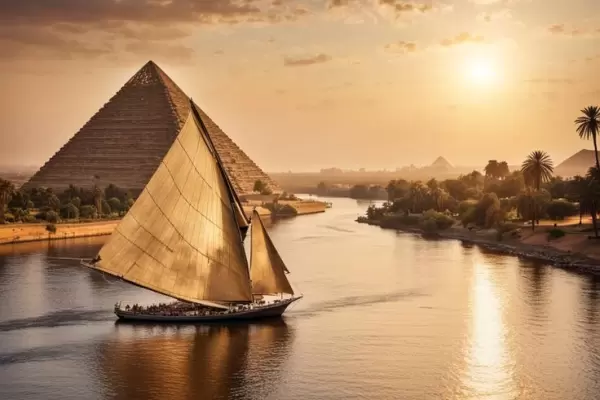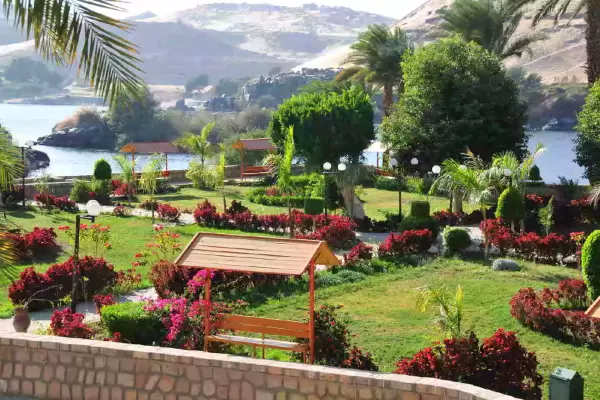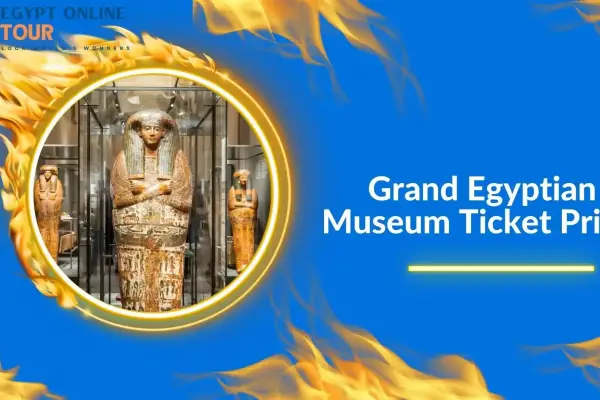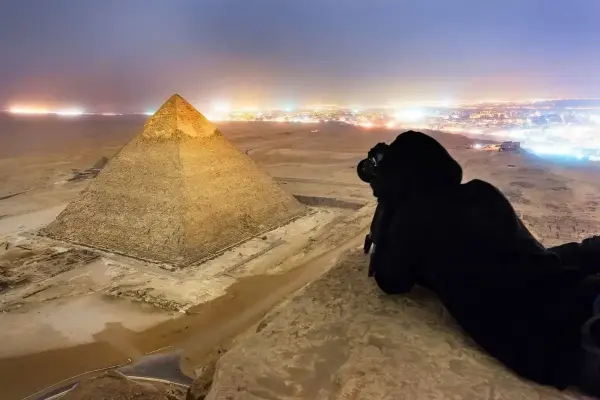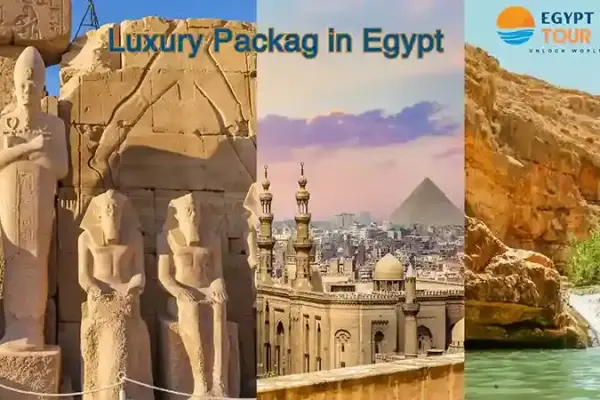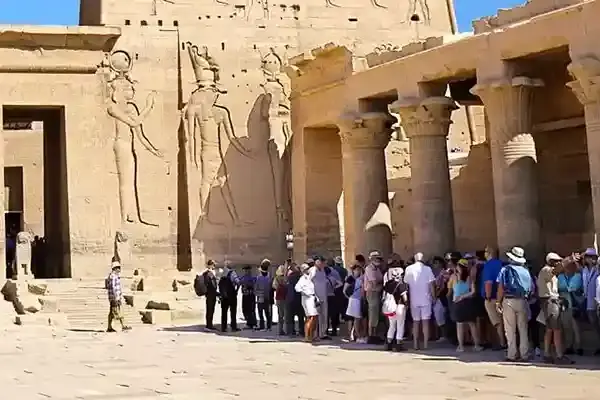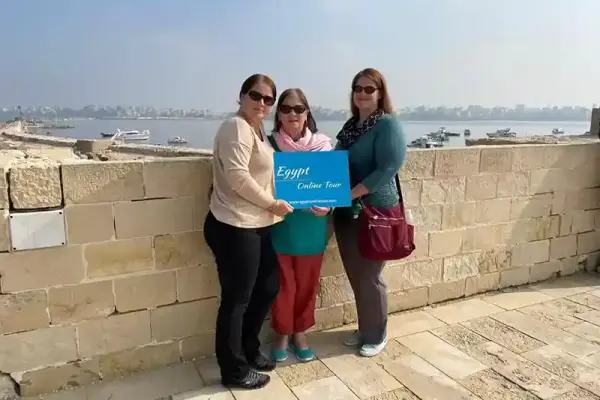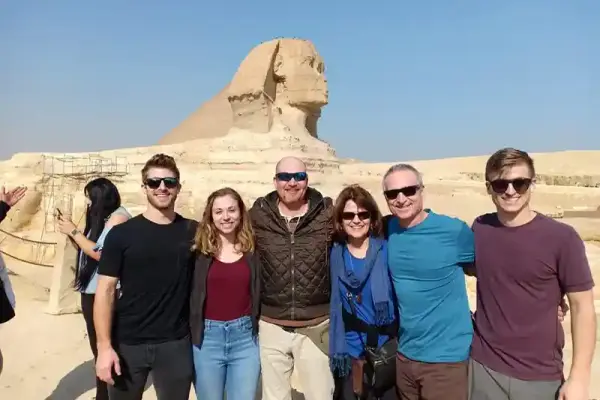Table of contents [Show]
- The Grand Nile River of Egypt
- The Influence of the Nile on Egyptian Civilization
- The Fertile of Nile Valley and Delta
- Pharaohs and Pyramids: Wonders Beside the Nile
- Luxurious Nile River Cruises
- The Agricultural lifeline of the Nile River
- Traditional flood festivals
- The Ecosystem of the Nile River
- The Nile's Secrets Through Hieroglyphs
- The Nile’s Treasures: Luxor and Aswan
- The Traditional Egyptian Sailing
- The Nile's Mysteries: Mummies and Tombs
- Cairo Nile Attractions
- The contrast between The Red Sea and The Nile River
- The Impact of the Nile River on the Egyptian Culture
The Grand Nile River of Egypt
Such a wonder of this land is the River Nile of Egypt, founded at the very beginning of the rise and growth of ancient Egyptian civilization. Its source lies in the highlands of Africa, right through the heart of Egypt; it astonishes by shaping history, culture, and landscape with our Egypt Travel Packages like Egypt adventure tours or Luxury egypt tours This mighty river winds its way through golden sands and lush vegetation to the key of eternal glorious Egypt: from mesmerizing pyramids and pharaohs down to the green Nile delta and its vivid wildlife. Take this amazing journey to the secrets of the Nile River Valley, seek out the secrets of the life-giving and cyclically flooding river, and share in the rich cultural heritage mirrored in ancient hieroglyphics and traditions.
Egypt's Grand Nile River has amazing scenery, a rich historical background and life-altering cultural encounters With the expertly guided tours available through Egypt Online Tour experience the amazing beauty of the Nile in our Egypt Online Tour Guide.
The Influence of the Nile on Egyptian Civilization
The Nile River is the reason behind the very existence of Egyptian civilization, this annual flooding deposited sediment, commonly known as silt, making the land an agricultural paradise, Grateful abundance, providing a reliable food supply, turned out to help maintain complex societies and vibrant culture for the Egyptians a captivating civilization today.
Indeed, it has been thousands of years that the Nile River has been indispensable to the Egyptian civilization, this river played a significant part in establishing ancient Egyptian society by slicing through the fertile Nile Valley and the extensive delta. This supplied the early Egyptians with two primary resources: land and water. This further enabled them to develop a sophisticated culture.
The Fertile of Nile Valley and Delta
The Nile River banks formed the core of the ancient Egyptian being. Its many channels and tributaries opened up even further stretches of fertile land to cultivation and settlement in the form of the Nile Delta. It is from these areas that the authority of the Egyptians emerged to leave some of the most famous sites: the Pyramids of Giza and the temples of Luxor.
An aerial view of the Nile Valley with lush green vegetation that lines the sides of the river should give an idea of how the Nile would have sustained the growth of ancient Egyptian civilization. The river should be dominant in the scene, serpentine with bright bluish-green coloration. The landscape around should be warm in earth tones with tiny plots of fields found on the banks. A few boats can be depicted floating down the river, and the omission of people or animals within the image would further improve the impression of serene beauty and historic value.
Today, people from all over the world throng the Nile River and its breathtaking "landscape," so evocative of the lasting legacy of ancient Egyptian civilization enjoy and learn about ancient Egypt with tailored Egypt Classic tours Packages Whether taking a Nile cruise or touring the valley and delta, the romanticism oozing out from this fabled river is unquestionably a showcasing of its pivotal place in the tapestry that is Egyptian history and culture.
Pharaohs and Pyramids: Wonders Beside the Nile
Ancient Egypt's most famous landmarks lined the river Nile. It was here that the "pyramids" and the Sphinx were raised. They were the work of the mighty "pharaohs" who ruled the land, the pyramids astound people with their size and ideal shape. They were the last resting places for Egypt's pharaohs. They express the competence and organizational ability of ancient Egyptians, The next wonder is the human-headed lion, which mixes the body of a lion with the head of a pharaoh. It is a giant statue carved from a single block of limestone. Its secrets have long interested people, together with the connection it shares with the Nile.
These wonders were built not by pharaohs who were mere rulers but were themselves closely linked with the Nile. The river was an integral part of their religious life and everyday life, which we see through "hieroglyphics" and other remains left behind by them.
Even now, the remains of those ancient times and the Nile do evoke our feelings and leave us in a state of awe. They allow us to have a glimpse into the details of ancient Egypt's vibrant history.
Luxurious Nile River Cruises
The legendary Nile River cruise for an all-embracing experience of the rich history of Egypt, coupled with breathtaking views, enjoy top-of-the-line luxury cruise ships and little boutique boats offering world-class amenities, delicious local cuisine, and fabled views, you'll see ancient sites as you sweep down the Nile: the magnificent Temples of Karnak and Luxor temple in Luxor, the mighty Aswan High Dam, and the beautiful Philae Temple in Aswan, lining up the banks on either side of the river are a great number of well-preserved temples and tombs that offer an in-depth probe into Egypt's history. The Nile River cruise includes the best of both worlds: relaxation and cultural investigation. You will experience one of the wonders of the world in the comfort of a floating hotel.
The Agricultural lifeline of the Nile River
The basic force that moved ancient Egyptian agriculture was the regular flooding of the Nile. Year by year, the river would overflow its banks and fructify the surrounding lands with silt. This natural process left really fertile soils able to carry out sufficient harvests which could feed the Egyptian population and provide sales for the economy. The predictability of the floodings of the Nile allowed for the rising and development of high farming techniques, and from there, it was extended towards a contribution to the blossoming of greater society compositions and advancements along the river. The failure stabilizing factor of the reliable agriculture provided by the Nile flooding was critical for feeding large urban centers and supporting the construction of very large monumental structures such as pyramids. He also adds that the floods became a powerful element of Egyptian cultural and religious life, where the Nile was worshipped by the people as a divine present, and the annual inundation of the river was still a real agricultural lifeline that fed the blooming civilization of Egypt, enjoy the most Luxury tours in the great Nile River on our Egypt Nile Cruise packages.
Traditional flood festivals
Most of ancient Egypt's flood festivals and rituals were centered on the annual flooding of the Nile River. Wafaa el-Nil means "Endurance of the Nile," a celebration of the rise of the river and a commemoration of the growing season. The other major ritual, the Sailing of the Barque of Amun, offers a sacrifice to the gods to secure a great harvest. These festivals of flooding gave the Egyptians an avenue through which to give thanks for the life-giving waters of the Nile and the consequent renewal of their land. The rituals pointed to the closest possible association between the Nile River and ancient Egypt, thus exhibiting what way that natural events influenced the culture and sustained the civilization, this legacy left by these festivities represents the lasting effects of this periodical flooding of the Nile on Egyptian society.
The Ecosystem of the Nile River
The Nile River is the lifeblood of Egypt, a bursting ecosystem full of varied wildlife; among the most iconic inhabitants are the huge hippos. It's quite a scene to see one break the water surface as it lounges in the shallows. Other favorites were the elegant Nile goose, recognizable by its sleek black-and-white feathers glistening in reflection as it glided across the water, not only hippos and geese find their way into the Nile but also now its share of fish, different birds, and the Nile crocodile, all of them very important elements in this diverse setting, for a nature and wildlife enthusiast, nothing can be better than a visit to the Nile River with the added advantage of seeing these magnanimous creatures at close range. On the other hand, this merry-making of wildlife in this river is an indication of the unconquerable beauty and might of nature, located in one of the most iconic settings in the world.
The Nile's Secrets Through Hieroglyphs
The Nile River was the lifeline of ancient Egypt, and such tremendous history can be outlined and found on temple walls with complex hieroglyphs. This effectively projects civilization and history by the Egyptians and depicts their familiarity with the river. For centuries, the meaning of these hieroglyphs remained a mystery, until the 19th-century discovery of the Rosetta Stone. Inscribed on the stone was the same text but in three different languages such as hieroglyphics, demotic script, and Greek, now scholars could finally decipher the meaning of the symbols, which described in great detail the great influence the Nile had on life in Egypt. Hieroglyphics were not just writing but pictures of natural surroundings, animals, and daily life along the Nile. Such is the case with symbols like the lotus, the perch, and the crocodile, which outline just how the river was relevant to its culture. In these ancient texts, leaders, religious rituals, and reign achievements are reported as ways that the Nile is central to the existence and merger of the civilization that was Egypt.
The Nile’s Treasures: Luxor and Aswan
From its point of history, the very important leaders of that great Nile River are the Luxor and Aswan. Luxor itself is the city of Theues and is very rich in iconic places, from the Karnak Temple Complex to its grand two obelisks and impressive hall to the place called the Valley of the Kings, a testament to the hip of ancient Egyptian art and grandeur, it is one of the favorite cities, combining stunning beauty with an intimate relationship to the Nile and thus a host to the legendary Temple of Philae and an engineering marvel of the High Dam in Aswan, helping to control Nile floods, The unfinished obelisk in Aswan reveals the invaluable skills of craftsmen of old times and tombs, these towns will give a view of the deep culture and history of the Nile in terms of ancient achievements and modern innovations. Luxor and Aswan provide an exceptional exploration of the glorious history of Egypt and the unceasing part of the story of the Nile River in Luxor & Aswan Nile Cruise packages you can discover the magic of the Great Nile River.
The Traditional Egyptian Sailing
One of the most famous means of transportation there is the feluccas, small traditional boats for sailing on the Nile, reflecting typical Egyptian traditions in river travel. Belonging to the Nile itself, these small wooden boats have attracted genuine travelers by defining the feeling they are attached to, it is the epitome of taking one back in time when the sails were filled with wind, and the rhythmic lapping of the water on the boat used to create a peaceful ambiance. As you sail along, the classical Egyptian landscape opens up with all their ancient sites. A ride in a felucca is, in a way, not just a ride, it is a cruise to the detailed pages of Egyptian rich sailing heritage in the hands of a skilled captain, whose techniques have been passed through generations. Immerse in a real sailing experience as you are summoned through the lapping waters of the Nile, taken away by the wind to another time.
The Nile's Mysteries: Mummies and Tombs
Along this mighty Nile River, ancient Egyptians developed complex tombs for interring their pharaohs and nobles as mummies, thereby providing a rich record of their burial practices and beliefs. The Valley of the Kings is the necropolis on the west bank of the Nile in the vicinity of Luxor that has revealed many very well-preserved mummies, among them that of King Tutankhamun, The wall carvings and hieroglyphics in these tombs give real insight into the spiritual and cultural life of ancient Egypt, Some of the major discoveries include the necropolis of Saqqara, just opposite Cairo, where the oldest known mummy has been found, dating back over 4,500 years ago. The Bent Pyramid at Dahshur and the step-pyramid of Djoser, seated on the Nile River, have long been considered further testaments to great architectural and engineering acumen on the part of the ancient Egyptians, the Nile continues to yield archaeological treasures that put us in touch with the mysteries of ancient Egypt and the strength of human ingenuity.
Cairo Nile Attractions
Cairo is the beat of the throbbing capital of Egypt, situated at the confluence of the ancient and the modern world along the sublime Nile River, this crowded city has tapestries of history and culture with towering pyramids to monumentalize the engineering ingenuity of ancient Egypt, the tourist can get lost in legendary sites, the Giza pyramids or the Egyptian Museum holding an expansive compilation of artifacts that recount the tale of Egypt's fabled past, strolls along the promenades of the Nile lead one to the traditional taste of Egyptian food, boisterous markets, and street performers, while the Khan el-Khalili bazaar will demonstrate that mix of tradition and modernity, but it's not only the emblematic images of Cairo that overwhelm, it's also its cultural landscape, where museums, art galleries, and theaters come alive to pay off the artistic traditions of Egypt. Be it history or the ultra-modern face of urbanism, Cairo embodies an experience that is quite different from anything else: grandeur in the past sitting perfectly beside vibrancy in the present.
The contrast between The Red Sea and The Nile River
These two different landscapes are strongly represented in Egypt: the Nile River and the Red Sea. The Nile generally termed the "Giver of Life," meanders through green valleys, thus creating an oasis in the desert. This green corridor is dotted with ancient pyramids and temples that provide a view of the cultural heritage of Egypt. On the other side, it has beaches and coral reefs washed by the Red Sea that are the cleanest in the world, this is one enormous playground for snorkeling and scuba diving, with really transparent waters teeming with vibrantly colored sea creatures, cliffs and sequestered beaches offer a perfect scene either to relax or have some fun, visits to both the lush Nile River valley and the dynamic Red Sea allow one to have an overview of each of the country's contrasting natural wonders. Landscapes in Egypt, ranging from the life-giving waters of the Nile to stunning aquatic life in the Red Sea, give unique experiences about the country's extraordinary natural wonders.
The Impact of the Nile River on the Egyptian Culture
To the ancient Egyptians, the Nile River was a very significant aspect of their culture and religious beliefs or traditions, it was considered one of the greater fountains of life and associated with several gods. The story behind the myth of Osiris, god of the underworld, associated the Nile with life and death as a symbol, it was there that he was torn limb from limb and thrown into the water but resurrected, Associating with the afterlife through the god of mummification, Anubis, the Nile advanced its role within Egyptian funerary practice, Hapi was the god of the annual Nile flood, which brought the water necessary to fertilize the land and ensured agriculture and prosperity. Since the annual inundation was marked with festivals and rituals, therefore it underlined the general importance of the river in spiritual and cultural life, it is by this very means that mythological relations reflect the status of the Nile as a source of life, and fertility, and as a bridge to the afterlife central in the ancient Egyptian worldview.
Interest in the Nile River has always been felt because it is based on the underpinning of Egypt's history and culture. Life-giving flooding made the lands of the Nile Valley and Delta rich for one of the earliest and most advanced civilizations in the world to be born. It is there that the rise of the pharaohs and the construction of pyramids took place, among other historical wonders down through the years. Even today, one of the mainstays of attraction to visitors from all around the globe flocking to feast their eyes on its beauty, rich history, and cultural and natural wonders is the Nile River, which flows right through the very heart of Egypt. Either by navigation of its waters, visits to ancient places, or wildlife viewing, the Nile retains the role of being a timeless source of life and wonder, embracing in itself a perspective view between Ancient and Modern Egypt with Egypt Online Tour.
Popular Categories
Related properties
Cairo, Aswan, and Luxor
-
Precio
$ 2,850
-
Tipo
Package
Cairo, Aswan, and Luxor
-
Precio
$ 1,850
-
Tipo
Package
